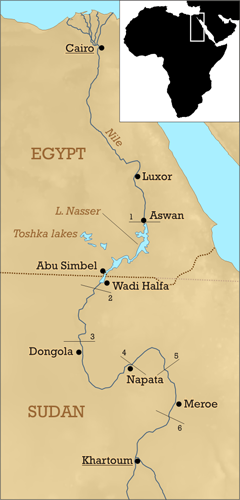'via Blog this'
Acts 8 — An Ethiopian
So he [Philip] got up and went; and there was an Ethiopian eunuch, a court official of Candace, queen of the Ethiopians, who was in charge of all her treasure; and he had come to Jerusalem to worship, (Acts 8:27 NAU)
Where was Ethiopia in the first century? One might immediately think of the modern country of Ethiopia. And, I am certain that many modern Ethiopians might think so.
By checking numerous reliable sources, it becomes obvious that the terms Ethiopia in Acts 8 describes the ancient kingdom of Meroë. It was also known as Cush and Nubia in ancient times.
The ETHIOPIA referred to here is not the modern country of the same name but the ancient kingdom of Meroë, which lay along the upper Nile S of Aswan to Khartoum in the Sudan. (The International Standard Bible Encyclopedia, Rev. Vol. 2).
The map of the region of Nubia also shows the 6 cataracts of the Nile from Aswan in Egypt to Khartoum in Sudan.
One of the older sources says that the country we now call Ethiopia took rise about the middle of the first century A.D.
Another kingdom, that of Axum in the mountain region of Abyssinia proper, seems to have taken its rise about the middle of the 1st cent. A.D., but that does not come into view in our present inquiry. (Feltoe, (Hastings) Dictionary of the Apostolic Church).
R. H. Smith, in The Anchor Yale Bible Dictionary, says,
The place name “Ethiopia” (possibly meaning “land of the people of burnt faces,” i.e., dark skin; cf. Jer 13:23) appears, as such, only once in the Bible (Acts 8:27), but in the LXX it usually translates the Heb kūš (Cush), a name which appears several dozen times in the OT.
The building of the new Aswan dam by modern Egypt formed Lake Nasser, stretching south from Aswan for about 340 miles into northern Sudan. This made it necessary for the Nubians to be resettled around Aswan. Some of the famous monuments of Abu Simbel were covered by the lake. The Nubians are easily distinguished from the Egyptians because of their dark skin. They (and the Cushites) were distinct in the ancient Egyptian paintings and statuary.
Many of the Nubians have been employed in the tourism business. I wonder how they are surviving since the recent revolution.
Can the Ethiopian change his skin Or the leopard his spots? Then you also can do good Who are accustomed to doing evil. (Jeremiah 13:23 NAU)
The distance from Jerusalem to Ethiopia could be as much as 1500 miles. Quite a trip in a chariot.



No comments:
Post a Comment